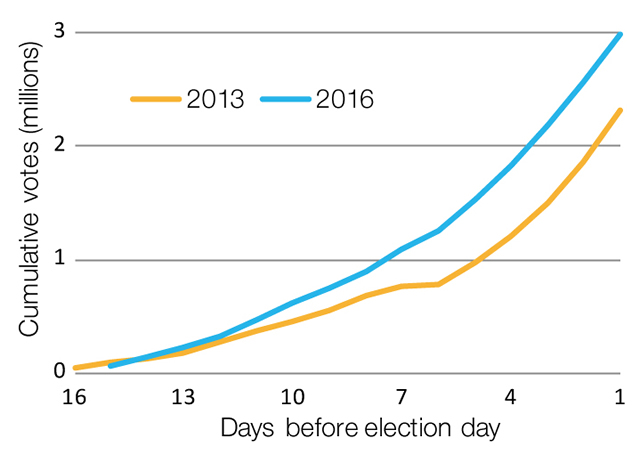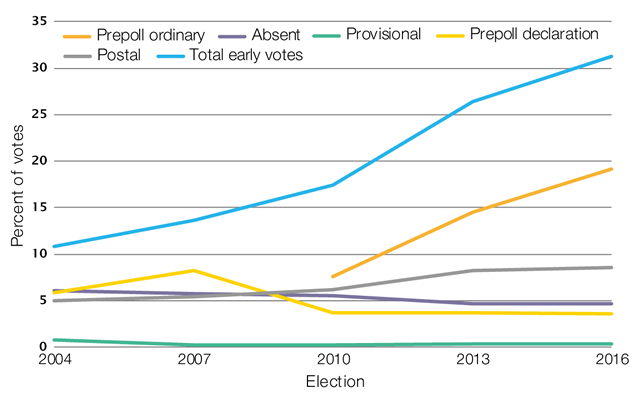Dr Damon Muller, Politics
and Public Administration
Key Issue
The 2016 federal election was the first double dissolution election in almost 30 years.
The election was called due to industrial relations legislation, however Medicare emerged as the most prominent issue in the campaign.
The Government was returned with a reduced majority of 76 of the 150 House of Representatives seats, losing 14 seats, and with a two party preferred count of 50.36 per cent.
The 2016 federal election returned the Coalition
government with a much reduced majority of, at the time of writing, 76 seats in
the 150 seat House of Representatives.
Redistributions
A number of electoral redistributions fell due in
the 44th Parliament, including New South Wales (NSW), Western Australia (WA),
and the Australian Capital Territory (ACT). Redistributions were also due for
the Northern Territory (NT) and Tasmania, but were deferred due to the
proximity of the election.
The Electoral Commissioner’s November
2014 entitlement determination found that population change in NSW and WA
resulted in NSW losing one seat and WA gaining one seat, with no change in the
overall total of 150 seats.
The new Western Australian seat of Burt was created
out of parts of the existing divisions of Swan, Tangney, Hasluck and Canning.
It was calculated to be a fairly safe notional Liberal Party seat.
In NSW the division of Hunter was abolished, with
Charlton being renamed Hunter. The division of Throsby was renamed Whitlam, in
honour of the late former Prime Minister Gough Whitlam.
In the ACT the division of Fraser (not named after
the late former Prime Minister Malcolm Fraser) was renamed Fenner, allowing the
name Fraser to be assigned to another division in the future in honour of former
Prime Minister Fraser.
Timeline
On Sunday 8 May Prime
Minister Turnbull announced that the 2016 federal election would be held on
2 July 2016.
Both Houses of Parliament were dissolved on 9 May,
and writs for the election were issued one week later, due to be returned on 8
August 2016. Polling day was 2 July 2016, and the first House of
Representatives seat was declared one week later on 9 July. The first Senate
results, for the NT, were announced on 25 July.
Electoral participation
Due to the length of the election period, the writs
were issued a week after dissolving the Parliament. As the close of rolls is
fixed at one
week after the writs are issued, this allowed an extended period for voters
to be enrolled after the announcement of the election.
Perhaps partly due to the longer than usual close
of rolls period, but also partly due to the Australian Electoral Commission’s
(AEC’s) direct enrolment programs, the number of people enrolled for the 2016
federal election reached over 15.6
million, an increase of almost a million voters since the 2013 federal
election. The AEC reported that 95 per cent of eligible Australians were
enrolled, compared to 92.4 per cent at the 2013 election.
One consequence of this increase in the enrolment
rate was a corresponding
decrease in the turnout rate (the proportion of enrolled people who voted).
At just under 91
per cent, the turnout rate was the lowest since the introduction of
compulsory voting in 1924. The turnout rate at the 2013 election was 93.23
per cent.
While the turnout rate was down, the higher
enrolment rate meant that a slightly higher proportion of the eligible
population voted (Parliamentary Library calculations indicate 86.27 per cent in
2016 compared to 86.19 per cent in 2013).
The double dissolution
The 2016 federal election was the first double
dissolution election in 29 years, and only the seventh since Federation.
Previous double dissolution elections were held in 1914, 1951, 1974, 1975, 1983
and 1987.
A double dissolution is a mechanism set out in
section 57 of the Australian
Constitution to resolve fundamental disagreements over legislation
between the House of Representatives and the Senate.
Legislation becomes a ‘trigger’ for a double
dissolution election under section 57 if the Senate twice rejects, fails to
pass, or passes the legislation with amendments unacceptable to the House of
Representatives, with more than three months between the first and second
introduction in the lower house.
At a normal election only the House of
Representatives is dissolved, with all members of the House of Representatives,
the two senators for each of the territories, and half of the senators for each
state, facing election. In a double dissolution the Senate is also dissolved,
and all 76 senators for the states and territories face election. For more
details about the effect of the double dissolution on the Senate election, see the
related Briefing Book article ‘The new Senate voting system and the Senate
result’.
The ‘triggers’
The specific ‘trigger’ Bills that led to the 2016
double dissolution election related to industrial relations. The three Bills
that were listed in the proclamation
dissolving both Houses of Parliament were the:
The Constitution requires that a double
dissolution be held at least six months before the expiry of the term of the
House of Representatives, meaning that the dissolution had to occur prior to 11
May 2016.
Proroguing the Parliament
On 21 March 2016 the Prime Minister advised
the Governor-General to prorogue the
Parliament; the Governor-General accordingly prorogued the 44th Parliament
and ended its first session on 15 April. The Parliament was summoned to meet
again to commence its second session on 18 April 2016. This was the first
prorogation and commencement of a new session prior to an election in
almost 40 years.
The Senate considered the Prime Minister’s
nominated Bills amongst its first pieces of business when it returned on 18
April 2016, negating
both the Australian Building and Construction Commission (ABCC) Bills that
day. The next day the Prime
Minister announced that he would be seeking a double dissolution of the
Parliament from the Governor-General, and nominated his preferred election date
of 2 July 2016.
The campaign
There were 55 days between the Prime Minister
announcing the election and polling day, and no single issue dominated the
lengthy campaign. Some topics (for example milk prices) were topical early in
the campaign, but had faded by polling day. Other issues that arose during the
campaign included penalty rates, economic management, marriage equality, negative
gearing and housing affordability, and asylum seekers.
The topic that had the most resonance by the end of
the campaign was the Australian Labor Party’s (ALP) claim that a returned
Coalition Government would privatise Medicare, which became known as the
‘Mediscare’ campaign. In his election
night speech, the Prime Minister labelled the Mediscare campaign ‘some of
the most systematic, well-funded lies ever peddled in Australia’.
The subject of the ABCC—the Prime Minister’s
nominated legislative impetus behind the election—was not a major topic of
debate in the campaign.
Early voting
The continued rise of pre-poll voting
The 2016 federal election continued the trend seen
in the past several elections of increasing numbers of voters choosing to cast
their vote early, with—31 per cent of the votes cast before polling day in
2016—around 4.5 million votes, according to Parliamentary Library calculations.
This compares to 26 per cent, or 3.6 million, votes in 2013.
Pre-poll ordinary votes—those early votes cast at a
pre-poll voting centre in the elector’s own division—once again made up the
largest proportion of early votes.
Figure 1: Pre-poll voting by day, 2013 and 2016
federal election

Source: Parliamentary Library based
on AEC data.
Postal voting
While pre-poll ordinary votes draw most of the
early voting attention, the long-established institution of postal voting also
continued to see a rise in numbers. The 2016 federal election saw 1.2
million postal votes, up from 1.1
million in 2013, with over 8.5 per cent of the votes cast being postal
votes.
Postal votes can be received and entered into the
count up until 13 days after polling day. Postal votes require a much more
involved scrutiny process before the vote can be entered into the count, unlike
ordinary pre-poll votes which are entered into the count like an ordinary vote
taken on election day and are usually all counted on election night.
The steady increase in postal voting is a
significant contributor to the delay in declaring the result of the election
particularly given that postal votes were essential to the final result.
As the ordinary votes, which are counted sooner,
and the postal votes, which are counted later, tend to favour different parties
in different ways, the high number of postal votes was largely
responsible for early fears of a hung parliament.
Figure 2: Early voting over recent federal
elections

Source: Parliamentary Library based on AEC data
The results
In the House of Representatives, the final
tally saw the Liberal National Coalition win a
total of 76 House of Representatives seats, down from 90 seats at the 2013
election. Ten of those 76 seats were won by The Nationals, an increase of one
since 2013.
Due to the close margin of the original count of
only 8 votes, the AEC ordered a re-count in the division of Herbert. After the
recount Herbert was won by the ALP by a margin of 37 votes.
Including Herbert, the ALP won 69 seats, up from 55
at the 2013 election. The Greens retained their one seat (Melbourne,
Vic.), as did Katter’s Australia Party (Kennedy,
Qld).
The Nick Xenophon Team (NXT) won one seat in the
lower house from the Liberal Party (Mayo, SA), and the independents Cathy McGowan (Indi, Vic.) and Andrew Wilkie (Denison, Tas.) retained their seats. The Palmer United Party (PUP) lost its
single seat (Fairfax, Qld) to the Liberal National Party.
While not the finalised result, the Coalition
received a national
two-party preferred vote of 50.36 per cent, a swing
against it of 3.13 per cent, and the ALP received 49.64 per cent.
Nationally, NXT achieved a vote of 1.85 per cent in
its first outing as a party contesting federal lower house seats. The Greens
received a national swing towards them of 1.58 per cent and PUP experienced a
5.49 per cent swing against it.
At the time of publication, there were not enough
complete Senate results to include.
Back to Parliamentary Library Briefing Book
For copyright reasons some linked items are only available to members of Parliament.
© Commonwealth of Australia

Creative Commons
With the exception of the Commonwealth Coat of Arms, and to the extent that copyright subsists in a third party, this publication, its logo and front page design are licensed under a Creative Commons Attribution-NonCommercial-NoDerivs 3.0 Australia licence.